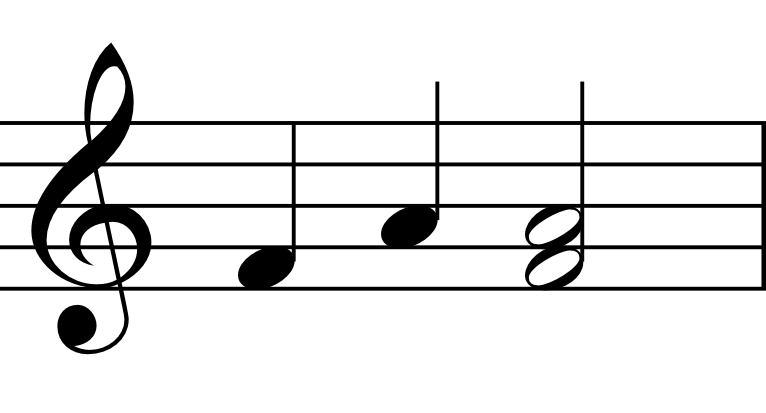When we look at music we need ways to measure between pitches. We call the distance between two pitches an interval.
Melodic and Harmonic
Melodic interval – two notes in succession (horizontal)
Harmonic interval – two notes played at the same time (vertical)

Interval Size
Intervals have two parts. Size is the generic visual distance on the staff (2nd, 3rd, etc). Make sure you can identify generic size quickly.

(We call them octaves rather the eighths.)
Interval Quality
There are multiple kinds of each interval size. We clarify these differences with interval quality (perfect, major, minor, etc.). By combining size and quality we can name the particular sound of each interval (major second, perfect fourth, etc.).
There are two sets of interval qualities:
- Intervals that can be perfect:
- Unisons
- 4ths
- 5ths
- 8ves
- Intervals that can be major or minor:
- 2nds
- 3rds
- 6ths
- 7ths
Combining Size and Quality
A helpful way to see intervals in action is in a major scale.
All intervals above Do in a major scale are either major or perfect.

All intervals below Do in a major scale are either minor or perfect.

The other intervals can all be derived from this system by increasing and decreasing intervals by half step.
- If you make a perfect or major interval larger, you get an augmented interval.

- If you make a perfect or minor interval smaller, you get a diminished interval.

- If you make a major interval smaller, you get a minor interval.
- If you make a minor interval larger, you get a major interval.

We can visualize these two interval systems (perfect and major/minor) in the following table.
| Unisons, 4ths, 5ths, 8ves | 2nds, 3rds, 6ths, 7ths | |
|---|---|---|
| Larger Intervals | Augmented |
Augmented |
| Perfect |
Major | |
| Diminished | Minor | |
| Smaller Intervals | Diminished |
Writing Interval Names
We writing interval names, we need to find a way to tell the difference between major and minor. Please either draw a line over the lowercase m for minor, or use “ma” for major and “mi” for minor. It makes no difference to me, just as long as I can tell the difference.
Compound Intervals
Simple interval – smaller than an octave.
Coumpound interval – octave or bigger.
If we add 7 to any simple interval, we get its compound equivalent (2nd plus an octave = 9th). Here are the next octave of interval sizes and their simple equivalents. Note a double octave is a 15th.

We will often reduce compound intervals to their simple equivalents, such as calling a 10th a 3rd.
Interval Inversion
If we take an interval and move one note up or down an octave, we get a new interval. This process is called interval inversion.

The way intervals invert is consistent:
- 2nds <–> 7ths
- 3rds <–> 6ths
- 4ths <–> 5ths
- Major <–> Minor
- Augmented <–> Diminished
- Perfect stays Perfect
One way to remember interval inversions is make sure they add up to 9. What is the inversion of a 2nd? 9=2+7. So, the answer is a 7th.
Memorizing Intervals
You need to memorize intervals as soon as possible. Every other theoretical idea you will encounter while in college is grounded in having intervals embedded in your mind.
Learning all of the white note intervals is a great place to start (no accidentals!). You can use these for comparison against any other interval you will see that has an accidental to help you find the correct answer. It is also helpful to memorize all of these intervals in solfege.
Diatonic Ascending Intervals in C major and Major Solfege
Minor Second (m2)
- E-F (Mi-Fa)
- B-C (Ti-Do)

Major Second (M2)
- C-D (Do-Re)
- D-E (Re-Mi)
- F-G (Fa-Sol)
- G-A (Sol-La)
- A-B (La-Ti)

Minor Third (m3)
- D-F (Re-Fa)
- E-G (Mi-Sol)
- A-C (La-Do)
- B-D (Ti-Re)

Major Third (M3)
- C-E (Do-Mi)
- F-A (Fa-La)
- G-B (Sol-Ti)

Perfect Fourth (P4)
- C-F (Do-Fa)
- D-G (Re-Sol)
- E-A (Mi-La)
- G-C (Sol-Do)
- A-D (La-Re)
- B-E (Ti-Mi)

Augmented Fourth (+4)
- F-B (Fa-Ti)

Diminished Fifth (°5)
- B-F (Ti-Fa)

Perfect Fifth (P5)
- C-G (Do-Sol)
- D-A (Re-La)
- E-B (Mi-Ti)
- F-C (Fa-Do)
- G-D (Sol-Re)
- A-E (La-Mi)

Minor Sixth (m6)
- E-C (Mi-Do)
- A-F (La-Fa)
- B-G (Ti-Sol)

Major Sixth (M6)
- C-A (Do-La)
- D-B (Re-Ti)
- F-D (Fa-Re)
- G-E (Sol-Mi)

Minor Seventh (m7)
- D-C (Re-Do)
- E-D (Mi-Re)
- G-F (Sol-Fa)
- A-G (La-Sol)
- B-A (Ti-La)

Major Seventh (M7)
- C-B (Do-Ti)
- F-E (Fa-Mi)
